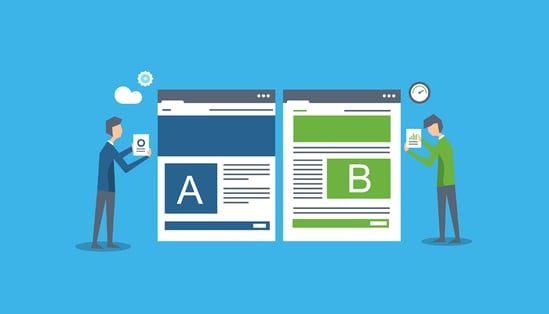Everything You Need To Know About E-Commerce A/B Testing (A Complete Guide)
Research shows that customer experience is perceived by 44.5% of organizations around the world as a central competitive differentiator (Statista, 2021). Therefore, customer experience is not something that is taken lightly by eCommerce businesses. On the contrary, eCommerce marketers and owners of eCommerce stores go out of their way to ensure the most seamless shopping experience for their customers.
There is no shortage of tactics and strategies you can follow to offer a better customer experience. However, you should ask yourself: Which strategies would be more suitable for my business? What changes should be made to my eCommerce store to improve customer experience?
Instead of just giving you answers to these two questions, we are offering you something better. In this article, we will be teaching you how to get answers to such questions all by yourself. Just like the Chinese proverb says: “ Give a man a fish, you feed him for one day. Teach a man to fish, and you feed him for a lifetime.”
So instead of randomly giving you strategies to improve customer experience, which might be suitable for you today and obsolete tomorrow, we will teach you how to figure out the right strategies by yourself each day through something called “E-Commerce A/B Testing”.
Read the following article to know what is E-Commerce A/B Testing, how it is related to customer experience, how to implement it, what its benefits are, and how to use it for eCommerce.
Table of content:
- What is E-Commerce A/B Testing?
- How to implement E-Commerce A/B Testing?
- What are the benefits of E-Commerce A/B Testing?
- Areas to use A/B Testing in E-Commcerce.
- Example of An E-Commerce brand using A/B Testing.
What Is E-Commerce A/B Testing?
A/B Testing, also called Split Testing, is a method followed by marketers to test the performance of certain variables and elements with their audience. In other words, it is an experimentation process in which two different versions of a variable are shown to different groups of people at the same time and in a random way. This test aims to determine which version is more successful in providing a better user experience.
In eCommerce, A/B testing can be used to improve the customer shopping experience with your website. For example, testing two different versions of a webpage or a landing page to see which version gets more visitors or drives more conversions.
Additionally, eCommerce marketers can use A/B testing within their marketing campaigns. To demonstrate, testing two different versions of a paid ad or of an email to see which version gets more clicks or drives more traffic to the website.
Whether you are using eCommerce A/B testing to test variables in your website pages or your marketing campaigns, the idea of A/B testing is the same.
How To Implement E-Commerce A/B Testing?
To better understand, the basic steps for eCommerce A/B testing may look like the following:
- Identify your goals and objectives for running the test.
- Formulate a specific hypothesis aiming at increasing conversions.
- Create a variation based on your hypothesis. This “variation” is the new version that you will A/B test against the already existing version, which we call “Control”.
- Split your audience into two equal segments: Group (1) and Group (2).
- Show the “Variation” version to group (1), and the “Control” version (B) to group (2).
- Gather the results and evaluate them.
- Decide which version was more successful, and start working on your optimization process.
Note that: There is an endless number of variables that you can test using eCommerce A/B testing; however, always keep in mind that, with A/B testing, we change only one variable at a time. This is because if we change several variables, we will not be able to know which variable led to the results.
What Are The Benefits Of E-Commerce A/B Testing?
We already agreed that the biggest goal you can achieve through eCommerce A/B testing is optimizing your customer experience. This is supported by a long list of benefits that A/B testing offers for eCommerce businesses.
-
A better understanding of your customers
We are already aware of how crucial customer segmentation is for eCommerce. E-Commerce A/B testing helps you deeply understand your target customers, which is as important as the process of segmenting them, if not even more important. E-Commerce A/B testing will help you determine what works best for your target audience, their specific wants and needs, and the different motivations that encourage them to buy.
Converted.In can help put you on the right track when it comes to customer segmentation because it provides you with a marketing automation tool that can easily segment your target audience without you making any significant effort. All you need to do after that is to work on better understanding these customer segments.
-
Reduce Customer Acquisition Cost (CAC) and Cost Per Acquisition (CPA)
E-Commerce businesses spend a lot of time trying to reduce their Customer Acquisition (CAC) and their Cost Per Acquisition (CPA). These two metrics are extremely significant for the profitability and growth of your eCommerce store. To illustrate better, CAC includes all types of costs related to acquiring new customers, and CPA focuses specifically on the marketing costs incurred to make a prospect take an action that leads to conversion.
E-Commerce A/B testing helps you identify the areas of cost where you should invest more and the areas that do not benefit your customer experience; hence, you should not be taking your money.
Looking at it from another aspect, eCommerce A/B testing helps optimize customer experience, which can enhance customer loyalty and retention. And we all know that an increased customer retention rate means decreased CAC and CPA.
-
Reduce Churn Rate and Cart Abandonment Rate

Customer Churn Rate, which refers to the number of customers that stop purchasing from your eCommerce store over time, can be lowered with the help of eCommerce A/B testing. The same thing goes for Cart Abandonment Rate.
E-Commerce A/B testing helps you determine the reasons customers stop visiting your website, the reasons they stop buying from you, and the reasons they abandon their carts at the checkout process.
-
Increase Return On Ad Spend (ROAS) and Return On Investment (ROI)
In the previous points, we already covered that E-Commerce A/B testing can lead to an increase in customer retention rate and a decrease in CAC, CPA, customer churn rate, and cart abandonment rate.
Now it is only normal to expect an increase in return on ad spend (ROAS) because the better you optimize your website using A/B testing; the more paid traffic will turn into sales and the higher your ROAS will be. All this will optimize your conversion rate and eventually increase your return on investment (ROI) in general.
-
Optimize your decision-making process
E-Commerce A/B testing allows you to make more informed decisions regarding, for example, your eCommerce website, your paid ads campaigns, or your email marketing campaigns. In other words, with eCommerce A/B testing, all your decisions are driven by data, numbers, and statistics.
Areas To Use A/B Testing For E-Commerce
Now you are probably wondering where exactly can you use A/B testing. In this part of the article, we are going to show you the different areas in which you can implement A/B testing for your eCommerce business.
1- Landing Pages
Your eCommerce landing pages are one of the first areas that can benefit from eCommerce A/B testing. The goal here is to make the customer’s experience while visiting your landing page as seamless as possible to ensure conversion. There are many variables that you can test in your landing pages, such as:
- Call-To-Action (CTA): E-Commerce A/B testing allows you to test different versions of CTA on your landing page. Try testing different CTA copies, button colors, button fonts, button shapes, and button placements across the landing page.
- Landing Pages Headlines, Sub-headlines, Colors, and Designs.
- Images: E-Commerce A/B testing can also help you test different versions of images to feature on your landing pages.
- Forms: Landing pages usually include forms to collect customer data. E-Commerce A/B testing can help you test different versions of these forms to figure out which form appeals more to customers and is easier for them to fill.
Learn more about the best tips to optimize your landing page for greater conversions
2- Homepage
A/B testing can help you optimize the navigation on your eCommerce website’s homepage. For example, you can run two versions of your homepage, one with a dropdown menu and another with a horizontal navigation bar on top. This way, the test will help you identify your customers' preferred way of navigation.
3- Product Pages
Product pages on your eCommerce website are another area where you can use eCommerce A/B testing. The variables that you can test on your product pages include product placement, product images, product reviews, product price, text describing the product, page design, colors, fonts…etc.
4- Checkout Page
As we mentioned earlier, one of the benefits of eCommerce A/B testing is the ability to lower your cart abandonment rate. One of the ways this can become possible is by conducting A/B testing on your checkout page.
For a customer to complete a purchase, the checkout experience needs to be as smooth and simple as possible. However, your idea of a smooth checkout can be different from your customer’s idea. Here is where the role of A/B testing comes in.
5- Email Marketing Campaigns
Email marketing campaigns are another area that can benefit from eCommerce A/B testing. One of the things that an improved customer experience will be reflected in is an increased email open rate and email click rate. E-Commerce A/B testing can help you with that. Among the variables that you can test in your emails:
- Frequency of emails.
- Email subject lines and Preview Texts: E-Commerce A/B testing can help you test different versions of subject lines and preview texts to see which version compels the recipient more to open the emails and click on links inside them.
For example, you can send one email version to a group of people, including their names in the subject line, and you can send another version to another group of people but with standardized subject lines. This way, A/B testing will help you identify whether your target audience responds better with or without email personalization.
- Call-To-Action (CTA): Just like we said that E-Commerce A/B testing could help you test CTAs on your landing pages; it can also help you test them in your emails.
- Testimonials: E-Commerce customer testimonials are a great tool to deal with customer skepticism. In addition to your website pages and social media platforms, they can be added to your emails. Through A/B testing, you can figure out which type of testimonial works better for your target audience.
6- Paid Ads Campaigns
One common area to use A/B testing for the benefit of eCommerce is to test two versions of an advertisement to see which version gets more clicks, leads to more website visits, and results in more conversions.
E-Commerce A/B testing can be applied to your social media ads and your search ads. The variables that you can test here include the ad copy, ad creative, headline, CTA… etc.
Speaking of email marketing campaigns and paid ads campaigns, the automation tool offered by Converted.in can also help you create, customize, launch, and automate your personalized ads, SMS, and email marketing campaigns.
7- Content Marketing Campaigns
Content marketing is one of the strongest strategies on which eCommerce businesses depend today. Fortunately, it is also one of the areas where you can benefit from eCommerce A/B testing.
For example, you can use A/B testing to test two versions of the same content: one that is long and in-depth and another that is short and can be skimmed through in a few seconds. This will help you identify the content depth that appeals more to your customers.
Example Of An E-Commerce Brand Using A/B Testing
After discussing what eCommerce A/B testing means, how it works, what its benefits are, and where we can use it, it is time to see a real-life eCommerce business using A/B testing for the optimization of customer experience:
SmartWool
SmartWool is an eCommerce store that sells socks and other similar products for men, women, and kids. The reason we are discussing this brand here is that it shows a clear example of how an eCommerce business can use A/B testing to improve customer experience and increase conversion rates.
SmartWool conducted an A/B test on its website pages following the basic steps we mentioned at the beginning of this article:
- It started by identifying its goal behind the A/B testing, which was to increase the average revenue per website visitor.
- It formulated a hypothesis that assumed that changing the layout of the category page in a certain way would lead to a higher average revenue per visitor.
- Smartwool created a variation based on this hypothesis:
- The Control version of the category page displayed the products in different sizes.
- The variation version of the category page displayed all the products in a repetitive fashion and in the same size. - Smartwool segmented its target audience into two groups.
- It showed the “variation” category page to one group and the “control” category page to the other.
- After running the A/B test for a while, Smartwool started gathering the results: The variation category page resulted in a 17.1% increase in average revenue per visitor.
- Smartwool started optimizing its category pages according to these results.
Final Thoughts:
To sum up, eCommerce A/B testing is indispensable if you want to stay ahead of the competition to provide a seamless customer experience. Therefore, you must keep in mind all the benefits of eCommerce A/B testing that we’ve discussed and work hard on leveraging every single one of these benefits.
 By
By

